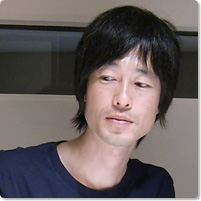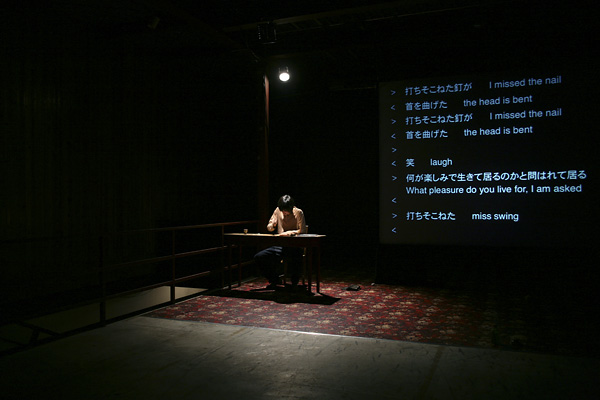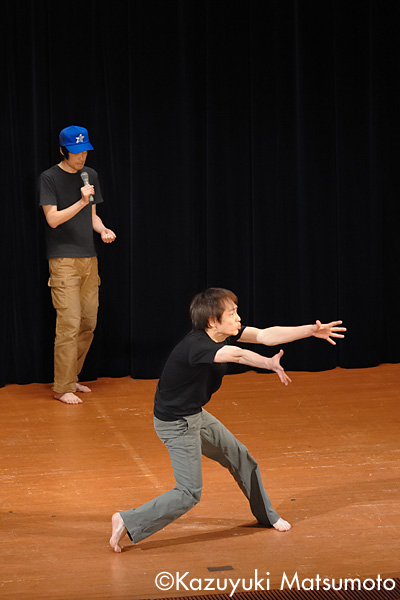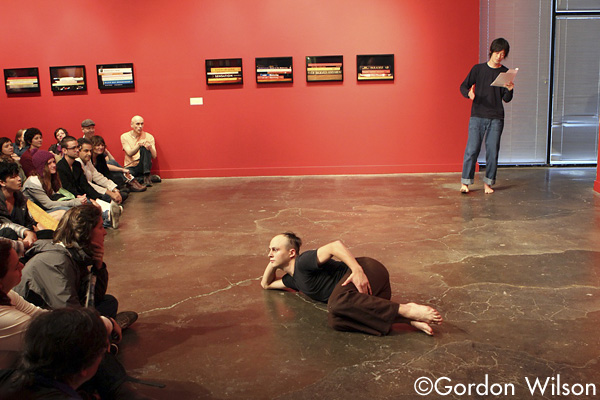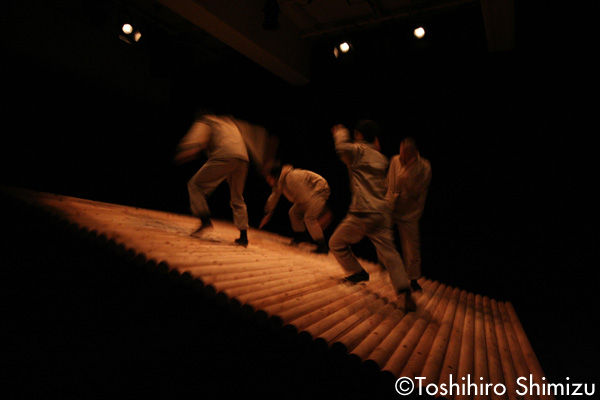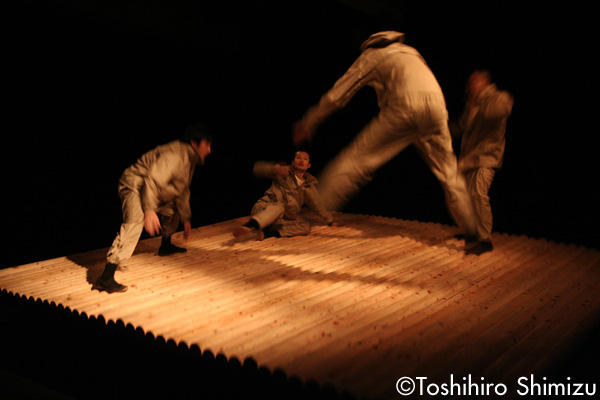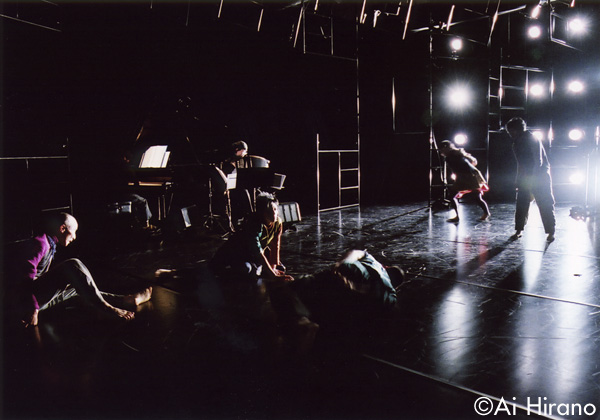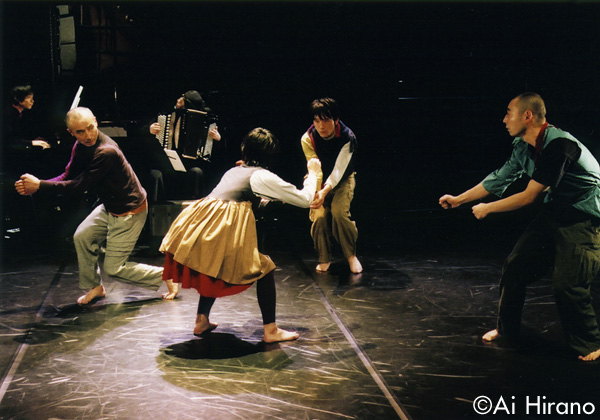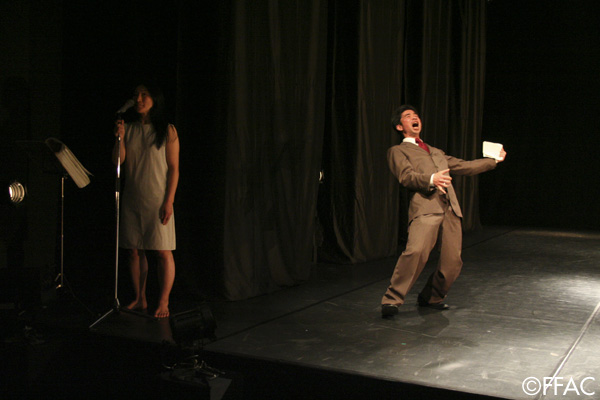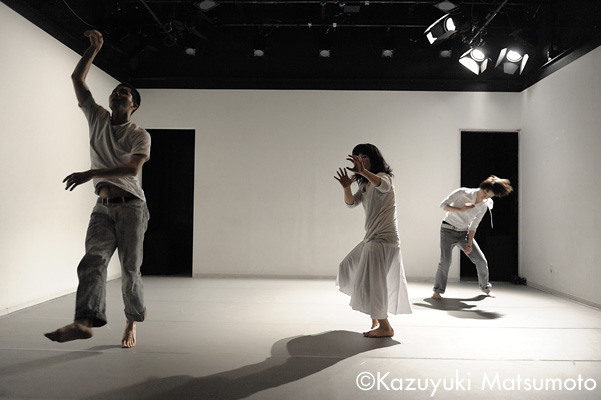- We have heard that you began dance at the age of 19. Could you tell us what prompted that?
-
I grew up in Neyagawa city in Osaka and I was a child with a father who always had me playing chess (Japanese go), and I was the type that liked reading and wasn’t very good at athletics. The first form of self-expression I became involved in was guitar, which I began in high school. I had a rock band, but even as I was doing that I realized my talent wasn’t in music, so I began looking for another form of expression that suited me better. That is when I happened to see a performance by the butoh dance company Sankai Juku. That was my first experience with dance.
It was shortly after that when I encountered the solo dance work of Toru Iwashita. As I watched him perform an outdoor dance work where he was moving in natural, hanging-out kind of mode in a garden. When I saw that I thought it could be another valid form of expression, and one that I felt some connected to me. Then I began studying dance at a studio for about a year. But, since I didn’t really have the physical attributes of a dance, I decided that simply studying dance like that wouldn’t lead me too much, so I started doing solo street performance. At the time, Osaka was alive with the events like the 1990 International Garden and Greenery Exposition, Osaka, and I started doing performances in free spaces and station squares around the town where I would kind of hang around in pre-dance type movement. At that time, I happened to meet Kosei Sakamoto’s Monochrome Circus group who were working from a base in Kyoto. I decided to move to Kyoto and it turned out that I began participating in their works as a dancer from 1990. - It is rather difficult for me to make a connection between the kind of “hanging-out” dance you mention and the “contact improvisation” based work of Monochrome Circus. How did you become a participant in their works?
-
At the time, Monochrome Circus was a cutting-edge group doing high experimental new work. There were works that involved things like sneaking into a university at night and filling classrooms with candles and toilet-paper installations and then walking around slowly until dawn. Monochrome Circus had just been launched by a group of theater people and I happened along just at a time when they were thinking of bringing some dance people into the group. So, I was able to show them the things I had been taught at the modern dance studio I had been studying at. During the five year I spent as a member of Monochrome Circus, I performed in all their works.
I should mention that in Kyoto at that time the Dumb Type group was at its peak, made up mainly of students from the Kyoto City University of Arts. Also, the area around the Kyoto University West Campus and the Yoshida dormitories in the Sakyo Ward area was a place where artists could gather and I was able to absorb a lot there in fields like video and art there. That was where I met the composer Makoto Nomura, who I would later create works with. Being a member of Monochrome Circus, I was able to learn from step one about things like lighting and sound, how to rent a theater space, make leaflets and advertise, what production people were necessary and everything else you needed to put on a stage production. It is thanks to that experience that I am able to work independently like I am today, gathering the staff and dancers I need for each work I create and make a production out of it. - Your first work was Poetry reading of 1994 performed at Kyoto’s Gallery Maronie. Could you tell us what kind of work that was?
-
That was the first work they let me direct at Monochrome Circus. I wanted to choreograph a work but I knew nothing about how the working methods for choreography. There was always something that attracted me about sight of people reading books, so I wondered if I couldn’t use that as a motif. I told the gathered participants that we were going to do poetry reading and then I worked to see how many dance aspects we could bring into it.
The actual method I used was to have twelve people sit around a square table and take turns reading from books that they liked. As we practiced I observed their words and movements carefully and then worked out the choreographing and directing from the small events happening around the room and details of the movements of the other participants as they listened to the readers. - So, from the very beginning you treated words and movement as elements of performance existing on the same level.
-
That’s right. And I carried on that line of thought in creating the work
Family
the following year. This was the first project I undertook after going independent. That year, 1995, was the year of the Great Hanshin-Awaji Earthquake and the Aum Shinrikyo incidents. These were events that really changed the atmosphere in Japanese society. When I saw what had been the familiar cityscapes of Kobe suddenly reduced to a leveled field of rubble stretching off to the horizon, it made me begin thinking about what I could do as an individual. As I thought, I got the desire to create a work based on the concept of family.
My work Family doesn’t directly involve any elements of my own family. Instead, I had a friend who had been in the earthquake come on stage and tell about the events of that tragic day and other elements of their daily life for the audience to hear, and I interspersed that storytelling with dance interludes performed by myself and one female dancer dancing in unison. It was not a work that approached the earthquake disaster directly as a serious issue. Rather, I composed it with a fictional birthday party situation with the celebrations played out on stage in things like the singing of nostalgic old half-forgotten popular songs, all in an atmosphere that was part jubilation but at the same time having an undertone of sadness. Looking back on it now, I think I was unconsciously composing it in a way that used dance like a form of music, integrating the timing and rhythm of the movement with the other elements of the performance. - I believe that most people who strive to become dancers or choreographers they begin by going to see a great variety of stages to seek inspiration for their choreography and gradually develop their own movement from the elements they discover. In your case, however, it seems that you set out right from the beginning in pursuit of your own unique style of expression that was completely different from anyone else’s. I feel that is a very creative approach and I wonder, is that “going my own way” attitude something inherent in your nature?
- Yes, I think it is. Because, when I started out with my band in high school, I knew from the beginning that I didn’t want to do copies of other people’s music, so we were doing original pieces right from the start. With dance as well, I never had the feeling that dance was something I was good at, so I have always felt that I have to start from the beginning and create something of my own.
- During the latter half of the 1990s you were doing a variety of small projects.
- It was a period when I wanted to take my time to study things without rushing. I got a job at a tofu shop and used my earnings to go see a lot of stages and create small works of my own. In the Kansai region, there was a program at Osaka’s Torii Hall where people could present short works, so I did things like creating 10-minute works that were pure explorations of movement and performed at galleries or as a side-event at art exhibitions. I did performances like taking a full day to walk from my home to some particular destination, or using toy instruments and performing songs that the people who gathered would request. In response to my feeling that Family had been limited as a composition to connecting elements in a musical way, I tried dividing my works into ones that were pure explorations of movement and ones that were based on communication with the audience, and within those categories I did a lot of experimenting.
- Those of us in the Tokyo dance scene first became aware of “Zan Yamashita” as a person doing unique work in the Kansai (Western Japan region centered around Osaka) in the year 2000. Was your performance at the Yokohama ST Spot that year your first in the Kanto (Eastern Japan region centered around Tokyo) area?
- Yes. That took place thanks to the producer Matsue Okazaki, who came to see me perform at Torii Hall. The work I performed was Omoide (Remembrance) and it was part of a program of works by male choreographers. It was a work that I based on a story that my grandfather had written for children during World War II. I was shocked to discover that in content the story was a sort of glorification of the Japanese war effort, but I also had a sense that I had accomplished something new by making a work out of it. That is because it was a period for me when I was looking for ways to connect my dance to larger issues of society and history. I felt that with this story I could connect my own expressive work in dance to social and historical issues. That is why I felt that I had to make a work out of it. In the actual work, I read from that book my grandfather had written on stage while bringing out dancers wearing gas masks and playing a tape with the sound of bombers roaring overhead.
- In 2001 you performed the work The dog eats a leg in the Next Dance Festival at Shinjuku’s Park Tower Hall, which was a festival drawing a lot of attention at the time in Tokyo. Can you tell us about that work?
-
In the Next Dance Festival my performance was part of the “Mix Program” consisting of works by three artist groups recommended by the Yokohama ST Spot, Osaka’s Torii Hall and Tokyo’s Kagurazaka Session House. We each had 30 minutes for our performances and I was worried at first about how to create a work for such a large stage (since I had only worked on small stages until then). I decided to just put myself in the middle of that big stage alone with nothing around me and then try to see how much “dynamism” I could create from just my own body and self.
Until then, my working method in choreography had been to use video as a tool for editing down images of detailed movement into a piece, but I realized that wouldn’t work for filling a big stage. I decided to transcribe each movement into words and hand it out to everyone in the audience as text on a piece of paper. I wrote it out in words like, “This is the first movement,” “A bird falls,” “There are the words ‘A bird falls.’ ” The audience had this in their hands as text and I was on stage performing in a kind of dialogue with the audience. In the process of that dialogue the lighting in the audience seating area gradually dimmed out and I proceeded to act out the words in the order they were written on the text. - Did this work then connect to the work It is written there that you performed at the Itami City Ai Hall in 2002?
-
Yes. There was a lot of criticism of my performance at the Park Tower Hall by people who said that it wasn’t good to explain the contents and meaning of what I was going dance to the audience beforehand. But, since I had been aware of that aspect, I decided that as long as I was going to be criticized that way I should just proceed in that style for all it was worth. In the premiere there were five of us performing, myself, three dancers and the “master of ceremonies” type narrator/director. A 100-page text was handed out to everyone in the audience before the performance and we performed each page as a scene.
While working up this piece in the studio, I tried a lot of different movements and did a lot experimental stuff using the dancers. In the process, I made memos on cards of all the phrases or sentences or pictures that occurred to me as material for the eventual text [script book]. In all, I had about 500 memo cards. I laid them out like a deck of playing cards and used them in a working process where I would pick a card and, while imagining in my mind the stage situation, say, “If the words on this card become such-and such a movement on stage, what would happen if this card came next?” Doing this over and over, I arranged the cards in one order after another.
Using this process, “connected sequences” gradually took form in my mind. The result, I believe, is something a bit different from the “chance operation” of John Cage or Merce Cunningham base of coincidence. What I was seeking was a type of connection based more on “the inevitable,” or things that were right of necessity. - I believe that It is written there was an epoch-making work for you that established your uniqueness as an artist. At the time you created it, how did you intend to develop the relationship between “word and movement”?
-
As I thought about how to do choreography that didn’t rely on any of the existing forms of dance technique, it occurred to me that by translating each movement into words and allowing the dancer to move within the words, it would create a situation where, although the words provided limitations, there would be no restraints on the dancer in terms of movement. Thus, I thought it would be a form of choreography that would offer a great amount of freedom. Said in another way, I thought that words could provide a method by which providing a framework [of words] would free the choreography and allow the dancer to move and play creatively within that framework. Playing chess (go) as a child I learned the fun of playing with an opponent within a given set of rules of the game. That may be one of the experiences that influenced this approach.
It was through a conversation with the composer Makoto Nomura, who I performed with in my work The dog eats a leg , that I first became consciously aware of this method in specific terms. I learned that he remembered all the music he had ever written. Just one glance at the musical score for a piece he had composed was enough for him to be able to play it all, note for note. In contrast, looking at videos of my past works made me realize that I couldn’t remember anything choreographed. That made me ask myself what I had that I could remember forever, and I concluded that the things I could remember would in fact represent my real creative work. I knew that I had never forgotten the words of songs I liked or passages from novels I liked. So, I thought that if I could leave my dance compositions in word form I would probably be able to remember them. That is when I became conscious of words as a methodology for dance. - What I found so interesting about your text [script book] for It is written there was what a varied mix of codes each page contained. In some cases there were just words in the form of individual noun, and sometimes the words were in sentences with subjects and verbs. Sometimes there were just blank spaces and sometimes cartoon-like drawings. In the actual performance the 100-page text and the movements of the four dancers are playing out simultaneously. It seems to me that it must be very difficult for the dancers to memorize it all.
- Very difficult, and so we practice very hard in the studio to get them to learn it all. I want to create works that give the audience the feeling that nothing they are seeing was decided beforehand but, in fact, creating that impression requires a tremendous number of devices and very detailed working of the piece into its finished form. And this work It is written there isn’t even one of the more complex ones.
- In 2003, you performed the work Invisible man at Ai Hall. In this work there is a “master of ceremonies” type narrator/director standing in front of a microphone on the stage reciting words for all the movements the dancers are performing. Unlike It is written there , the words are not written in a text but presented verbally. The performers included the narrator/director and seven dancers. What were intentions with regard to “words and movement” in this work?
-
This work was an expanded version of the piece
Yokohama Taizai
(A Stay in Yokohama) performed at ST Spot in Yokohama the year before.
Yokohama Taizai
was a work based on the concept of desktop-writing a dance while holed up in a weekly rental condominium in Yokohama, and it was performed by one dancer with me as the narrator/director. After finishing
It is written there
I wanted to experiment with using verbal presentation instead of the written word, so I created a work where the words I had written in Yokohama would be spoken on stage and linked to physical movement and the body of the dancer.
Yokohama Taizai
is a continuing work, being performed this year in Seattle [Washington] and Portland [Oregon], and
Invisible man
is its expanded version using several dancers instead of one.
The words used in these works are in fact a form of personal “diary.” It is composed of everyday diary entries like, “Today I arrived in Yokohama. It was raining. I saw a traffic accident from the sidewalk.” It then becomes a mix of dance and words from daily life. Some are abstract words thought up to express people’s movements while others are, conversely, dance words deriving from words in the diary. I write down lots of things I have imagined or things that happened in daily life, and in the process of changing the order and editing, it becomes a work where the words and the body movements separate at times and then come together at other times. I believe it also became a work with pauses that allow the audience’s imagination to fill in the gaps. Like It is written there , it is created through a process of editing a mix of word and bodily movement, but since I am talking from beginning to end in Yokohama Taizai and Invisible man , I believe the words and bodily movement are conveyed to the audience more directly and the methodology of the creative process is less visible. - In 2004, you presented one of your best-known works, It’s just me coughing . The words used in this work are all free-form haiku poems of Housai Ozaki. The poems are projected on a backdrop on the stage one after another. I believe Housai is known as a very unorthodox haiku poet. How did you come to know his work, and what were your intentions as you used his poems in your work?
-
Since I am choreographing with words, I naturally become increasingly sensitive to words and their potential. Haiku is a kind of poetry that takes the things encountered or happening before one’s eyes and expresses them in short phrases, and in that sense I feel a similarity with my choreography method. What’s more, Housai’s haiku poems tend to deal directly with his own physical perceptions. We see this in poems like,
Oh, I’m lonely/ I try opening out my five fingers alone
. That’s why I have long been aware of his poetry and know it because I like it.
It’s just me coughing is composed of about 70 scenes. Housai died young and all the poems he left enough fit in one book. From that book I chose all the haiku that deal with the body in some way and then I created cards with five symbols each for “inhale” and “exhale.” Then I filled them with haiku in the places I felt would be good within the physical process of my breathing in and out ten times. The result was that there were some cards that had only one haiku and others that had several. I also placed importance on the empty places within those ten breaths without haiku, which signified only breathing. As with the process I used for It is written there , I then laid the cards out on the floor and decided on the order for the composition of the work.
One person who saw the performance said to me, “You can see this as one day in the life of a person, and also as a person’s lifetime.” In composing it, however, I had no intention of giving it any sort of story line, I just picked up the cards in the order I felt good with looking at their haiku. So the whole just turned out that way by chance. - There is poetry in every culture in the world, but haiku with its 5-7-5 syllable composition is an extremely short form but still manages to contain very large emotional content, or seasonal nuance or a sense of the ephemeral nature of the things in the world. Housai wrote free-form haiku that didn’t usually adhere to the 5-7-5 form and his freely chosen words seem to carry undercurrents expressing the solitude and loneliness of existence. I sense that is what attracts you to his poetry. Could you tell us your thoughts about the strength of the images these words conjure up and giving them expression with the human body on stage?
-
When thinking about what dance is today, I believe you can say with certainty that it belongs to the audience. What we have to do in the performing arts is to consider each and every member of the audience and what image will arise there and connect with the audience and what context will expand outside the theater.
When there are words and the human body, what the dancers have to do is to see how much their body can communicate to the audience the objet of the words on the stage. I am often told that our bodies don’t have the strength to compete with the words, but I believe that if the physical presence of the dancer is too strong the dancer will absorb the words completely so the words no longer belong to the audience. When that happens, all that is left is the charisma [of the dancer] on the stage.
That is why I see the body as something that is in a sense weak and ephemeral—which is in fact its “strength”—and that technique is how you use of the body on stage to evoke thoughts and images in the minds of the audience. That is why the body should not be a charismatic thing and should not be too strong. The kind of dance I want to do is, rather, dance that communicates to the audience the words that are on the stage. That is the kind of body I want to be, and that is what “strength” means to me. - I thought that your performance of It’s just me coughing at the VACANT in Harajuku, Tokyo in 2010 was a very successful and fulfilling stage. What I felt there was a self that was weak and a body that was frail and transient in the face of words. The very absence of a straightforward philosophical statement was what gave expressive strength to the performance. Hearing your words just now I understand why I felt that. All three of these works involving word and body— It is written there , Invisible man and It’s just me coughing —were joint productions with Ai Hall, weren’t they?
- Yes. The producer at the time, Reiko Shiga, started the “Take a Chance Project” that had choreographers or directors from the Kansai region doing joint productions three new works at a pace of one work per year. I was chosen to be the first artist for that project. She told me, “I’ll be patient for three years, so take your time creating new works.” That was a great gift for me. In the end, I was able to create three productions under that program that have been performed again and again at different theaters since then. That was very encouraging for me.
- The following year, 2005, your work The Sailors premiered in Yokohama. It was a work performed on what would be a deck of a boat being tossed by the waves at sea and the dancers on that deck were the “sailors.” You deliberately created the unstable situation of a tossing deck on stage and had four dancers dance on it. After having created such a successful series of works involving word and the human body for so long, what made you change to a work that had no words at all and focused entirely on physical movement?
-
I felt that I had done what I wanted to do with the theme of the relationship between words and the body in the three works
It is written there, Invisible man and It’s just me coughing. To move on from there to the next step I wanted to search for a new working method for my choreography. In the case of
The Sailors, I used a set with a raft device that could be tilted and turned through a 360-degree range. This was an attempt to increase the “freedom” of the choreography by setting limitations on the dancers through making them perform on this unstable, moving platform.
I began by choreographing an entire piece for a normal flat, motionless floor, without the moving raft. Then, with the assumption of the piece being performed on the moving raft, I took the initial choreographed piece and thought about what measures or rules would be necessary to enable it to be performed on unstable, moving surface. At the premiere the work was still in an experimental stage, but after several subsequent performances I got away from the concept of “being on a boat” and became more interested in the process of searching for a methodology for choreography based on the assumption that a piece would never be performed under the same conditions twice.
Since I never begin working on a piece under a fully prepared set of conditions, the impulses of the moment become important. At first I do something inexplicable on an impulse. I may be criticized for the initial result, but after that I calmly begin to think about it, and there is a lot that I learn later from the subsequent self-critique. It is not only with this work but with others as well that I find myself doing subsequent performances of the same work under very different conditions, and I have learned that if I am persistent, there are numerous discoveries to be made each time. - I thought that the work Animal Theater you presented in the “Engeki Keikaku 2007” theater program produced by the Kyoto Art Center was also quite a successful work. The music of Makoto Nomura was an especially big element in this work. What made you decide to do a work using Nomura’s music from beginning to end?
-
Nomura did a CD titled
Zoorashia no Ongaku
(Zoorasia Music) consisting of improvisations he did while watching animals at a zoo. Watching a variety of animals including anteaters, monkeys and lions, he did improvisations on a keyboard harmonica in response to the calls and movements of the animals. When I saw that, I felt a very strong link to what I was trying to do with
The Sailors
in seeking a type of choreograph that could respond to all types of uncertain, changing conditions. That made me feel that I wanted to choreograph a piece for improvisational music done with animals. When I suggested that to Nomura, he offered to transpose the music he had done with animals into a musical score for piano and accordion. Then I set to work to choreograph and direct a piece with five dancers and the improvisational music with animals, and also choreographing movement to go with things like the scratching sounds and snorting sounds of the animals.
I believe that the direction I had been exploring in The Sailors involving “freedom and limitations” reached one form of completion with this work [Animal Theater]. It involved doing choreography to music, but in order to preserve the taste of improvisation, Nomura threw in some unexpected actions during the performance. He did things like suddenly leaving the piano and coming over to touch the dancers. But I had taken measures to ensure that the dance could accommodate such things. The piece was choreographed so that even if there should be a lapse in the originally planned music there would always be eye contact at certain points or there would be parts where one dancer would be certain to do a prescribed movement but the other dancers didn’t necessarily have to do it, so the movements that were originally to be done in unison could be taken apart and done separately without losing the overall timeline of the dance when something unexpected occurred. I believe that by choreographing this kind of freedom into the work it succeeded in becoming a dance work that looked as if animals were performing it. - In the three years since then you have performed several works overseas. Soko ni Kaite Aru was remade as It is written there in Belgium in 2008 for a performance at the Kunsten Festival des Arts. In your works the way the words reach the audience is a very important factor. How was that that work translated?
-
Belgium is a country with two languages, Dutch and French. What’s more the two communities are in opposition in many ways. The director was interested in bringing a work that his about words into that kind of environment. Since it is a work that has not only the text but also lines spoken on stage, we had meetings to discuss in detail what would be translated and what wouldn’t. In the end, it was decided to translate the text into English, which most of the audience would understand, while the spoken lines would be said in Japanese with subtitles projected simultaneously in Dutch and French, And for the scenes where the dancers speak directly to the audience, we had them learn those lines in Dutch and French. So it ended up being a very complex work where the dancers spoke in Japanese, Dutch and French, the subtitles were projected in Dutch and French and the text in the audience’s hands was in English and Japanese.
As a residence program for this festival, all the young artists went together to see performances and then met the next day to discuss them. Participating in that I met Fahmi Fadzil, who had also attended the same festival as me in Thailand the year before. Thanks to a Japan Foundation grant, I was able to go to Malaysia the next year, so I suggested to Fahmi that we do a work together. After the performance there of It’s just me coughing, there was time allotted for me to stay and do a project, so that is when we created DEWAMATA.
That same year I performed It is written there in Istanbul’s International Contemporary Dance and Performance Festival. Istanbul is a tourist capital where people from many countries gather. When those people come to a theater there are many people who don’t understand Turkish, we prepared two texts, one in English and Japanese and another in Turkish and Japanese, so the audience would have a choice. - In 2010 you presented another successful work titled Daikouzui (The Great Flood), which had a dozen of so LDC video screens on the ceiling showing video images while three dancers performed. Where did the image for this work come from?
-
It is basically the same theme that has been developed in
The Sailors
and
Animal Theater.
I first choreographed a work for three dancers to perform in unison and then experimented with ways to dissolve the unison movement. What I told them at the time was that there should be a way that communication could be made by taking a phrase like “good morning” and not saying the whole thing but just saying “goo …… ing.” Rather than doing an entire choreographed movement sequence, you could look at each other and in effect say that you were going to do just this part of it, or you could show that you were going to do this part very clearly because the others don’t usually do it. What’s more, you could do some part faster, or slower, or slightly out of synch with the others. In this way they could dissolve the choreographed movement through the sense of trust built up that way between the three dancers. Yet, all the time that original choreography is in the minds of the dancers, even if it is not visible to the audience from what they see happening on the stage. That sort of thing. I choreographed it in a way that left a lot up to the will of the dancers, allowing them to dissolve the portion from this point to this points at a degree of such-and-such a percent; and I would give them actual numbers for those percentages.
This was a work that was commissioned by ST Spot and I enjoyed it as an opportunity to work with a theater for the first time in a while and work up a dance piece with the young staff there. - Since 1994 you have been working independently trying this and that to create a performance world of your own. The result is that you have received a high level of recognition by a certain audience and have been invited to perform at important festivals like Kunsten Festival des Arts. In this sense I think it is safe to say that you have succeeded in creating a Zan Yamashita world. Now, what would you like to communicate to the next generation? What are the things that you are always concerned with?
-
Especially over the last two or three years I have had the opportunity to do collaborations with a number of Asian artists and I have found that moving just slightly to a new location can help bring whole new contexts into my work. Also, performing overseas had made me keenly aware of the existence of contexts in my work that I wasn’t conscious of before. Working steadily on my own has brought me some degree of recognition, but working too meticulously can also have the effect of cutting me off from the outside world. So I believe I have to make an effort to keep a balance between the inward searching and the outward opening up.
It is difficult to make a living as an artist, so it is often difficult to create works for the world audience or to travel and see other worlds, but I would like to communicate to the next generation the fact that simply being aware of another place can bring positive changes in your work. I wasn’t thinking about that while I was in Kyoto working at a tofu shop.
I believe that I will continue to press on with my own creative work, but I have learned that thinking about the possibilities of new places and contexts has brought added dimensions to the choreography I produce, so this is something I am extremely interested in now.
Upcoming schedule
Jan. – Feb. 2011
Facilitator for “Workshop Trial and Exchange” in “We dance 2011”
http://www.offsite-dance.jp
Feb. 17, 2011
“TPAM Direction” at “TPAM in Yokohama”
http://www.tpam.or.jp/
Sept. 2011
New work presented in Kanagawa Arts Theatre and Itami Ai Hallco-produced by Itami Ai Hall and ST Spot Yokohama
https://www.stspot.jp
https://www.aihall.com


